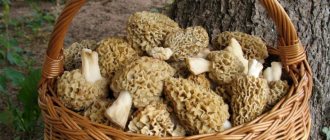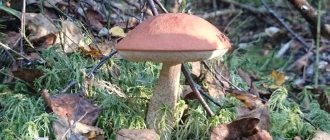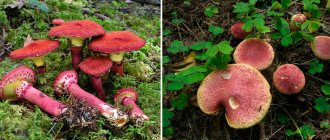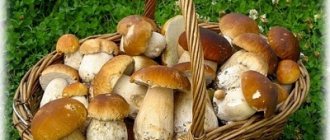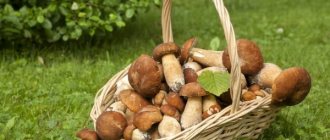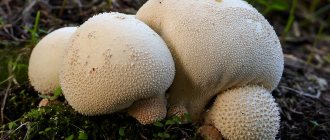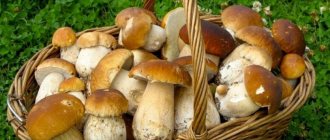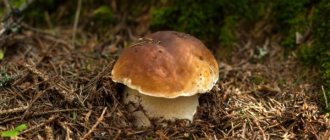Characteristics of mushrooms of Central Russia
In Russia, mushrooms grow everywhere. The total number of species of cap mushrooms (macromycetes) exceeds 2 thousand. Of these, almost 300 are edible mushrooms in the central zone of our country. And all this wealth for the most part remains unclaimed. Some are simply unfamiliar, others require additional processing. As a result, no more than thirty of the most common types are served on the table. Let's stop at them.
Characteristics of mushrooms of Central Russia
Autumn honey fungus (real)
In Rus', honey mushrooms have always been a desirable dish on the festive table. They grow on deciduous tree trunks, stumps and dead wood. The fungus is widespread in the forests of the Northern Hemisphere and is absent only in permafrost areas. Fruiting bodies appear en masse from late August to early September; under favorable conditions, they can be collected before the beginning of winter. Young honey mushrooms are a welcome catch in any mushroom picker’s basket. In our country it is difficult to find a person who has not collected them at least once in his life.
Honey fungus is a conditionally edible mushroom; if not properly cooked, it can cause digestive upset. Fresh product requires preliminary boiling for 20-30 minutes. Honey mushrooms are unpopular in the West, but in Eastern European countries they are considered one of the best representatives of agaric mushrooms. The gifts of the autumn forest are good when fried, boiled, pickled, salted and dried. Just 100 grams of honey mushrooms satisfy a person’s daily need for zinc and copper.
Classification
Depending on the location of the fibers under the cap, mushrooms are divided into lamellar (russula, champignons, umbrella mushrooms, pig mushrooms) and tubular (boletus, boletus, boletus). In the central zone of the country, the former predominate in percentage terms - about 88% of the collected mushrooms have plates.
There is also a relatively small group of marsupials, including morels and truffles, which have a specific appearance and excellent taste.
And a very small group of raincoats, distinguished by a special spherical shape of white color. After rain, they can be found in city parks and on lawns.
All mushrooms can be divided into several ecological groups:
- Xylophiles (consist of parasitic fungi: honey fungus, polypore, and saprophytes that prefer to feed on rotten wood);
- Soil saprophytes – morels, champignons;
- Mycorrhizal - porcini mushrooms, saffron milk caps, russula. the mycelium is in symbiosis with the roots of trees;
- Coprophiles - Umbrella mushroom, dung beetle. They like to grow in rich soils and pastures.
The appearance, chemical composition and taste vary; each mushroom picker has individual preferences in this regard.
General information
Since the times of the Soviet Union, 4 categories of mushrooms have been identified that carry a certain degree of nutritional value and intensity of taste:
- – the first category – the most pronounced flavor of mushrooms and high nutritional value. This group includes: boletus, milk mushrooms, saffron milk caps.
- – the second category – has a less pronounced taste and is much inferior in nutritional value to the first group. These are mushrooms: champignons, boletus, boletus.
- – third category – mushrooms are considered edible with average flavor intensity and relative nutritional value. These include: honey fungus, russula, green flywheel.
- – fourth category – organisms with the lowest nutritional value and barely noticeable taste: puffball, hanger mushroom, mottled moth fly.
There is no specific exact classification of edible and poisonous mushrooms, since in different regions of the country the names contain a mixture of several types of mushrooms. And their characteristics often become similar in many descriptions of mushrooms. As another option for classifying mushrooms, they are divided according to the complexity of preparation before eating.
The nutritional value
Mushrooms contain a large amount of protein, are rich in minerals, the energy value of porcini mushrooms is over 938 kJ, they contain vitamins and organic acids. In short, it is a storehouse of useful substances. But it should be remembered that mushrooms are difficult to digest, and people with chronic diseases should use them with caution.
Mushrooms contain a lot of amino acids and trace elements, which makes them an indispensable ingredient in the preparation of all kinds of dishes.
Fresh mushrooms, salted, dried, pickled - just the mention of them makes you hungry. In Russia, there is a tradition of always putting mushrooms on the festive table; during Lent, they successfully replace meat. Therefore, with the onset of the season, a huge number of mushroom pickers rush to a quiet hunt.
Nutritional value and cooking features
Fresh mushroom fruiting bodies are almost 90% water. Also, mushroom pulp contains about 3–6% protein and the same amount of carbohydrates. During the drying process, the amount of protein increases to 30–50 g for every 100 g of product.
The fat content in the pulp does not exceed 1%. The composition and nutritional value vary depending on the type and location of growth. However, almost all edible mushrooms are highly valued by consumers and nutritionists for their fairly balanced content of fiber, vitamins, minerals and extractives. Many varieties are suitable for universal preparation, for which they must first be prepared:
- a thorough examination of the fruiting bodies in order to identify slugs, various flies and bugs, leaves, soil and pine needles;
- rejection of broken and wormy fruit bodies, as well as pruning of the root part;
- it is necessary to remove the skin from the butter;
- Clean fruit bodies intended for drying and saffron milk caps for pickling with a damp cloth;
- thoroughly rinse mushrooms not intended for drying in running water;
- to prevent darkening, you can immerse clean mushrooms in a solution of citric acid;
- most milkweeds need to be soaked for several days, regularly replacing the water;
- pre-prepared fruiting bodies of edible species can be fried, boiled, stewed, pickled or pickled, and also used as a filling and for preparing mushroom caviar or cold appetizers.
It should be remembered that children under three years of age completely lack enzymes that are responsible for the digestion of specific mushroom proteins, so mushroom dishes should be completely excluded from the diet of preschool children.
Mushroom season
It begins immediately after the first thawed patches appear in the snow. Morels and strings are the first spring mushrooms. They grow on forest edges, on the slopes of ravines, and in fields. Externally they resemble brown brains. They are classified as conditionally edible and require pre-cooking before cooking. Very tasty and aromatic.
The first mushrooms may appear at the end of May
Each mushroom picker has his own treasured gathering places and his own calendar of visits.
The first: white boletus, boletus and boletus may appear in the spring (late May, June). They grow in clearings, in young mixed forests, and are often found along forest paths. The first wave of fruiting usually does not exceed a week.
Starting in mid-July, if there is enough rain, the most common edible mushrooms begin to grow massively:
- Boletus, also known as white, has a brown cap that sits tightly on a strong pear-shaped stem. It has a tubular structure of white or yellow-green color (depending on age);
- Boletus, also known as boletus, is a gray or gray-brown cap on a stalk covered with small gray scales. The structure under the cap is tubular, light in young mushrooms and gray in old mushrooms.
- The boletus is similar in appearance to the boletus, only the cap is red and turns blue at the cut site. Grows in mixed forest;
- Butterflies love the sandy soil of coniferous forests, have a brown slippery cap, and a light leg. Quite often they grow in groups;
- Ryzhiki - the name speaks for itself. The funnel-shaped cap has a lamellar structure, one bright red color with a stem. It is very fragile and aromatic;
- Honey mushrooms can be summer, winter, or meadow. They may differ in color (depending on the species) but always grow in colonies. The edible honey mushroom has a characteristic ring on the stem and scales. By these signs it is easy to distinguish it from the poisonous false honey fungus;
- Chanterelles are yellow in color, with a funnel-shaped, irregularly shaped cap that smoothly turns into a stem. The pulp is dense and never wormy;
- Milk mushrooms - there are white and black. The dense pulp is most suitable for pickling. Milky juice is released at the cut site. Before salting, soak for several days in salted water to remove bitterness;
- Russulas are the most numerous representatives of the mushroom world in central Russia. Color range from bright red to white. There are green, bluish, pink. Inexperienced mushroom pickers often confuse russula with toadstool due to the similarity in description;
- The umbrella mushroom grows in humus-rich meadows, in grazing areas, and in the forest. It is not particularly popular in Russia, but in vain. Individual specimens of this delicious mushroom reach 40 cm in height, the cap can grow up to 35 cm in diameter. It really does resemble an umbrella. They only eat the cap, the stem is too tough. It is easily confused with its poisonous counterparts.
According to the description, mid-August is the peak season. From this time until frost, late mushrooms grow by leaps and bounds. Tubular ones are faster, plate ones are a little slower. But the baskets fill up very quickly. And mushroom hunting pleases with trophies.
Boletus (boletus) and boletus: differences
Boletus (boletus)
Boletus can have either a brown, gray or even black cap and white or cream tubes, which can turn dirty gray with age. Its leg is thinner and higher than that of the boletus, white, with brown or black scales.
The only way to confuse the boletus is with the aspen boletus, whose cap is orange, brick-red or ocher-yellow. But here, as they say, don’t confuse, it won’t get any worse, because both of these mushrooms are edible and extremely tasty.
Boletus
It is best to collect mushrooms in a wicker basket: they will be ventilated and will not be crushed. Never use plastic bags, otherwise you will come home to find that you have brought back a shapeless, sticky mass.
Good luck to you!!!
Precautionary measures
Even the safest mushroom can become poisonous if it grows near a busy road, next to a landfill, or in a place with soil contaminated with hazardous waste. This should be taken into account when collecting.
Do not collect overripe or wormy mushrooms. It is strictly forbidden to take a Mushroom if there is even the slightest doubt about its edibility.
Read also: Autumn mushrooms: edible, names, which ones are collected, photos
Every good mushroom has a poisonous counterpart, and the consequences of inexperience or carelessness can be catastrophic.
When going to the forest, you can take with you reference books describing edible mushrooms, but if in doubt, it is better to leave the mushroom and let it grow further.
Elite appliances for your kitchen
Miele produces devices that improve the quality of life of a modern person. Premium equipment is manufactured in Germany using innovative solutions and high-quality materials. Ovens and cooktops are equipped with smart features that will help you cook delicious and healthy food. Miele refrigerators and freezers will create an ideal microclimate in which mushrooms, meat, fish, vegetables and fruits will be stored for as long as possible. The taste, aroma, appearance and beneficial properties of the products will remain unchanged thanks to advanced cooling and freezing technologies. You can order luxury appliances for the kitchen and home in our online store.
Varieties of edible mushrooms in central Russia
Due to their nutritional value and usefulness, mushrooms are called vegetable or forest meat. Their benefits include a large amount of vitamins, amino acids, carbohydrates and proteins. Mushrooms contain specific sugar - mycosis and animal starch - glycogen. The enzymes they contain accelerate the absorption of food by breaking down proteins, fats and carbohydrates.
More than three hundred species of edible mushrooms grow in the forests of the central zone, steppes and forest belts of the Caucasus and Kazakhstan. Fans of forest hunting prefer to pick mushrooms because the harvest can be enjoyed right in the forest, roasted over a fire. It is necessary to understand which types of mushrooms are poisonous and which ones are edible. Varieties of mushrooms are most often presented in encyclopedias with names and descriptions of appearance.
Oiler
The mushroom is one of the most common in the entire northern hemisphere. In favorable weather, boletus grows in large groups; when a thick layer appears, they are collected in buckets and boxes. In the southern regions of Russia, the first fruiting bodies may appear as early as early May, and in the warm autumn, harvesting continues until the end of November. The oiler prefers to grow next to young pines, but is often found in old mixed forests. The mushrooms owe their name to their oily cap, which should be removed before subsequent cooking.
Mushroom pickers collect large quantities of three types of butterweed: granular (summer), common (autumn) and larch. Small mushrooms are most often pickled or salted; this appetizer is traditionally served for the New Year and Christmas holidays. Butterfly is very good fried and in soups, it can be added to salads and main dishes as a seasoning (to add mushroom flavor).
Usable types
There are more than a thousand species of edible mushrooms, most of which belong to macromycetes. But some varieties are hybrids of fungi and plants. This category includes those that do not pose a danger to human health and life and are of particular value in cooking. They have a pleasant taste, and the prepared dishes do not become boring.
Good species are distinguished by a lamellar or spongy structure on the underside of the cap. Edible mushrooms also have other characteristics:
- frequency of arrangement of plates on the cap;
- spore color;
- method of attaching the plates to the leg;
- the color of the pulp before and after pressing on it.
The mycelium from which mushrooms emerge resembles light mold. She appears on a rotting tree. Its fibers entwine the roots of the tree, saturating it with organic matter and receiving in return moisture and mineral elements for nutrition. Some names come precisely from the type of tree to which they are attached.
The following types of mushrooms can most often be found in forests:
- common oakwood;
- pine mushroom;
- boletus;
- registry;
- boletus
Mushroom pickers in mixed and coniferous forests collect the following varieties:
- saffron milk caps;
- honey mushrooms;
- chanterelles;
- Champignon;
- boletus;
- Russula;
- milk mushrooms
After collecting mushrooms, it is best to put them in a wicker basket, which allows you to check them and maintain their original shape. It is better not to use the bag, as when you come home you may find a shapeless mass in it. It is necessary to collect only those mushrooms that are probably known to the mushroom picker. Wormy legs and old caps should alert a forest hunter. Morning is the best time for picking in the autumn forest, as the mushrooms are still strong and fresh.
Common chanterelle
This species is well known in Europe and Asia, growing in deciduous and coniferous forests. The color of the fruiting bodies can vary from light yellow to orange-yellow, and they have a faint aroma and taste of apricots. The chanterelle's hat and leg are one whole; there is no boundary between them. The mushroom is also popularly known as "Cockerel". The fruits are perfectly stored and transported; they are suitable for consumption in any form. Due to the presence of a special substance (quinomannose), chanterelles are considered kosher, since they do not contain worms. The sour taste disappears after boiling; the pulp contains 8 essential amino acids, many vitamins A, B, D, PP and trace elements (copper, zinc and others).
Signs of edible mushrooms
When studying the signs of edible mushrooms, it is very important to pay special attention, since in this case there is always a risk of running into toadstools. All of them are deadly poisonous, and are dangerous because they grow next to edible ones and have a similar appearance to them. Signs of poisoning may appear only a few hours after eating toadstools. Therefore, before picking mushrooms, you need to look again at the pictures with their images in the catalog and read the description.
All edible species are divided into four categories:
- The first includes high-quality noble mushrooms, the most valuable due to the large amount of nutrients and taste they contain (ceps, boletus and camelina);
- the second category has no less refined taste, but less nutritional value (butterfly, aspen boletus, common oakberry);
- mushrooms of the third category are found most often, but with a large number of noble species of the first category, they are bypassed (russula, trumpets, common chanterelles);
- The fourth category includes the least valuable mushrooms in terms of taste and nutritional value (putiki, valui, honey mushrooms).
Chanterelle: photo and description and similar inedible mushrooms
Chanterelles are very good because worms do not like them. Therefore, having found a colony of these beautiful mushrooms, you can be sure that half of the forest harvest will not have to be thrown away. Chanterelles are less likely than other mushrooms to accumulate harmful substances, so they are completely harmless to the liver and kidneys.
But at the same time they are very hard and are digested much worse than other mushrooms. Young chanterelles resemble egg yolk in color; they turn pale with age, and overripe specimens can be almost white. The middle of the cap of an adult chanterelle is pressed inward so that the mushroom is shaped like a funnel; young mushrooms have convex caps. The stem, fused with the cap, tapers downward.
False fox
Carefully! The common chanterelle can be confused with the inedible false chanterelle. They are no different in shape, but the color of the false chanterelle is quite characteristic, bright orange. But in old age, mushrooms turn pale and become indistinguishable from edible ones.
But it doesn’t matter: after all, chanterelles always grow in vast colonies; where there are old people, there are also young mushrooms, and the false chanterelle can always be identified by the color of these babies
Description of edible species
Mushroom pickers come across the porcini mushroom less often than other varieties, which is why it is so highly valued. In adults, the cap has a dark brown tint and yellow flesh on the inside. With age, the spongy part of the fungus becomes less elastic, but does not change color, unlike the inedible gall fungus, which looks like a white one. Representatives of this species grow alone in grassy or sandy forest clearings.
The boletus acts as an absorbent that removes toxins from the body. The mushroom does not have a specific odor, has a light brown cap with pinkish flesh and a light stalk widened downwards. The boletus is one of the edible mushrooms of central Russia, lives in birch groves on moist soil, and emerges from the ground after heavy rains.
The next mushroom of the first category is saffron milk cap. Its name is justified by the red color of the cap, which has an interesting funnel shape. The flesh of the lower part of the cap and the stem also have a carrot tint, but when pressed they become greenish. The resinous aroma and special taste of the mushroom are highly valued by chefs. It grows on sandy soils in pine forests in the Leningrad and Orenburg regions.
The tubular oiler belongs to the second category. The name comes from the oily brown-red cap. The juicy yellow flesh does not change when cut. The spherical cap of the boletus, located on a black scaly leg, is distinguished by lilac flesh. The bright leg of the common oak tree is hidden under a reddish cap with fleshy bright yellow flesh. All three species grow in the cool forests of Ukraine (mainly in the Donbass) and Belarus.
Read also: Edible and poisonous umbrella mushroom: how to distinguish these species, where it grows
The third category includes russula. Their second name - bruises - comes from the color of the cap. In rainy weather they become sticky, but remain dull until it rains. More than ten species grow on the territory of Kuban and Belarus. They tolerate long trips well, requiring long-term heat treatment. This species has light pink caps with red rings and a dense, light-colored stem.
Common chanterelles are considered a special delicacy, so named for the light red, almost transparent shade of their curly cap. The dense pulp of the mushroom emits a pungent aroma and has a pungent taste; it is never wormy, as it contains quinomannose. This is a substance that kills insects.
Putiki - mushrooms with a pungent, specific taste - belong to the list of the fourth category. Many mushroom pickers avoid them because they consider them poisonous. But when properly processed, young putiki have a pleasant aroma and special taste. Valuis, which have yellowish spherical caps with white dense flesh, have an unpleasant odor. You can only collect young mushrooms that look like small fists.
Honey mushrooms (honey mushrooms) grow in clusters of several dozen pieces, which do not change their habitat from year to year. They grow on old stumps and fallen trees in the Belgorod and Volgograd regions, and Siberia. The hats of October babies are brown-beige, and in places of high humidity they acquire a red tint. On the stem, as it grows, a thin film breaks, growing towards the cap.
Before picking mushrooms, you need to carefully study their photographs and the main signs of edible species. It is important not to make a mistake when hunting for mushrooms, as this poses a mortal danger to humans.
Porcini mushroom (boletus): photo and description and similar inedible mushrooms
There is a special category of mushroom pickers who disdain all types of mushrooms except porcini mushrooms. “Well, just an empty forest, I found only a dozen mushrooms!” - in their mouths, this does not mean at all that the forest is truly “empty”: they just won’t bend over for the sake of everything else.
You can do whatever your heart desires with porcini mushrooms: salt, dry, marinate, fry – and fry without boiling in advance. As a rule, they prefer to dry it - in order to eat delicious mushroom soup in winter.
A small boletus can be completely white, but with age its cap becomes brown, and then dark brown in color. Also, with age, the hat unfolds: in young babies it is semicircular, with the edges adjacent to the stem, in white adults it is unfolded, simply convex, and maybe flat.
The tubes (those on the underside of the cap) are initially white, then light yellow, then greenish, even completely green. The boletus leg looks like a barrel, widened downward, white or cream.
The porcini mushroom has other forms: reticulated dark bronze (with a dark brown, almost black cap), (with a slightly cracked cap), rooted (yellow-brown in color, with completely yellow tubes and stem and slightly blue flesh when cut) .
There is a royal boletus with a red cap and yellow tubes and legs. All of them are edible and extremely tasty.
Carefully! White mushrooms can be confused with inedible gall and satanic mushrooms, and also with the poisonous pink-golden boletus.
Bile mushroom
- Gall fungus, gall fungus (Tylopilus felleus) . An adult gall fungus has pinkish tubes and pores. It is not poisonous, but it tastes so bad that it is not without reason that it is called bilious.
Satanic mushroom
- Satanic mushroom, satanic boletus (Boletus satanas) . The satanic mushroom is distinguished by a red stalk (right under the cap it is yellowish) and orange-red tubes, the pores of which turn blue if you press on them.
Boletus pink-skinned or rose-golden
- Pink-skinned boletus, pink-skinned boletus, rose-golden boletus (Boletus rhodoxanthus) . Pink-golden, poisonous, boletus is very similar to the satanic mushroom: it has red tubes, which also turn blue when pressed, and the leg is yellow, but with such a dense red mesh that sometimes it seems completely red.
Silent hunt
There are a great variety of mushrooms in nature. Strictly speaking, mushrooms are a whole kingdom that unites representatives of eukaryotes, that is, living organisms that combine the properties of both plants and animals.
Mushrooms surround us on all sides; they live on the ground and underground, in water and in the air. Among them there are species growing in forests. And some can be eaten without the risk of poisoning.
Jokers usually say that you can eat all mushrooms, but some only once. This is true. Mushrooms growing in the forest are divided into the following types:
From a culinary point of view, it is the first group of this list that is most interesting. In central Russia, more than three hundred species of edible mushrooms grow. There are a lot of recipes for mushroom dishes. They are fried, added to soup, dried, pickled, and salted.
Edibles can be eaten without special preparation. It is enough to clean them, wash them and heat treat them. Conditionally edible ones require long-term soaking in order to get rid of unpleasant taste, smell or small amounts of harmful substances. They also need preliminary heat treatment.
Inedible mushrooms are not eaten because of their hardness, pungent taste or smell. Also inedible are poisonous mushrooms, which, in turn, are divided into poisonous, deadly poisonous and hallucinogenic.
Champignon
Several decades ago, champignons were considered a rare delicacy that could decorate the table of the elite. Today they have learned to grow champignons in different conditions. Mushrooms are not whimsical, have a delicate taste and smell.
Many gourmets prefer to eat mushrooms raw. Sauces, gravies, soups, and soufflés are prepared from champignons. Housewives prepare pies, pizzas and stretchers. The most delicious dish is stuffed champignons. You can add any filling you like to the hat.
Valuable and not so valuable
Each type of mushroom has its own nutritional value. The most healthy, nutritious and delicious ones belong to the first category. These are mushrooms such as:
- White mushroom;
- milk mushroom yellow;
- white milk mushroom;
- real saffron milk cap;
- The fox is real.
The second category is less valuable, but its representatives are also quite tasty and healthy. Their nutritional value is lower, and the taste is also not as bright. The second category includes;
- boletus;
- boletus;
- the rest of the milk mushrooms;
- white russula;
- champignon;
- oak tree
The third category is even less valuable, but still quite edible. It includes:
- other russula;
- honey mushrooms;
- flywheel;
- wave;
- morel;
- Valuy.
The fourth category is the last. It includes edible and conditionally edible mushrooms, which can only be collected out of despair, when there is nothing else. This includes:
Of course, there are much more edible mushrooms than on this list. Listed here are only the main edible mushrooms that are most common and are the object of collection.
Third and fourth grade
Representatives of the third category, and even more so the fourth, do not have significant nutritional or taste value, so there is no point in providing a detailed description of these mushrooms. Volnushki and valui are suitable for pickling; honey mushrooms are good both fried and pickled. Ultimately, it all depends on the cook and his abilities.
When collecting forest gifts, you should always adhere to the rule: “I don’t know, I don’t take.” It must be remembered that some mushrooms contain deadly poisonous toxins. You should also not collect in industrial zones, in the territories of abandoned military units, of which there are a lot, as well as along roads and power lines.
Mushrooms tend to accumulate heavy metals and radionuclides. So it’s better to choose ecologically clean areas for quiet hunting; fortunately, there are still enough of them in Russia.
First category
The porcini mushroom (boletus) is perhaps one of the most coveted trophies of mushroom pickers. Only white milk mushrooms stand in the same row with it. The cap of the boletus is convex, color from almost white to dark brown, dense to the touch. The bottom of the cap is light, greenish. With age it becomes green-yellow. The leg is barrel-shaped, thickened below, cream-colored with a pronounced mesh.
Boletus grows in almost all forests. Depending on the place of growth, it can form a symbiosis with birch, spruce, etc. Hence the variety of forms of this mushroom (spruce, birch, oak). There are about twenty of them in total.
Yellow milk mushroom is quite often found in coniferous forests with an admixture of birch. The cap of a young milk mushroom is flat and becomes funnel-shaped over time. The fringed edges are folded down and inward. Color from light yellow to yellow-ocher. The pulp is white, dense. The leg is white, straight, hollow inside.
Read also: Devil's fingers mushroom: edible or not, where the creepiest mushroom in the world grows
White milk mushroom also grows in mixed coniferous and birch forests. It occurs in large clusters, called piles, hence its name. The cap is slightly depressed, and over time takes the shape of a funnel. Its color is white, often with small yellow spots. The edges are shaggy and curved downwards. The pulp is strong, white. The cut produces a caustic milky juice that turns yellow in the air. White milk mushroom has a unique aroma and is highly valued for pickling.
Real camelina (pine) grows in the forests of the same name. Usually grows in large groups or colonies. The cap of the saffron milk cap is flat, and over time takes on a slightly depressed shape with the edges curved down and inward. Its color greatly depends on the place of growth and can vary from orange-red to dark pink. The flesh of the mushroom is dense and yellow. When cut, a milky juice of bright orange color is released.
There is also a spruce form. Spruce saffron milk cap is very fragile and does not tolerate transportation well. When scrapped and salted, it turns green. The taste is not inferior to its pine counterpart.
The real chanterelle grows in mixed forests, usually in large groups. It got its name because of the bright orange color characteristic of the animal of the same name. A young fox has a round, convex cap; over time, it stretches into an inverted cone with wavy, uneven edges. The pulp is fleshy, light yellow in color. The leg is narrowed downward.
Chanterelle is a natural antibiotic. It contains quinomannose, a unique substance harmless to humans that is not tolerated by helminths of all types. Thanks to him, chanterelles are never wormy. Eating chanterelles strengthens the immune system. In addition, this is the only mushroom that does not accumulate radionuclides.
The most popular mushrooms in Russia have been named
This week, Hyundai and Kia announced updated plans for the next 8 years. More than ten electric vehicles will be launched under the group’s brands, including in new market segments, including pickup trucks.
Sales of the Hyundai Ioniq 5 and Kia EV6, the first electric vehicles from the two Korean automakers, are in full swing, but this is just the beginning. By 2030, Hyundai will release 11 new electric vehicles: three sedans, six crossovers and a light commercial vehicle.
Hyundai started the intrigue by saying that they were preparing “one new type of model.” There are no details yet - it could be anything from an electric version of the Santa Cruz pickup truck to a tiny electric capsule like the Renault Twizy.
One of the new sedans will be the Ioniq 6, inspired by the Prophecy concept, which will go on sale this year, and one of the crossovers will be the production version of the Ioniq 7 concept, which will arrive in showrooms at home in 2024.
Prophesy concept
KIA
Genesis' premium division will add six new electric models to its lineup over the next eight years: two, presumably sedans, and four crossovers.
The first single-volume will be the Electrified GV70, planned for 2022. Starting in 2025, every new Genesis will be electric.
Meanwhile, Kia plans to launch two new electric vehicles a year to create a lineup of 14 models by 2027. Kia also plans to release two electric pickups - one premium and one for emerging markets.
Kia will also launch an entry-level electric car and the EV9, unveiled as a concept last year. The EV9 will be Kia's first electric vehicle to feature AutoMode autonomous driving technology. The system will then be available on all new models launched in major markets by 2026.
KIA EV9
KIA
After EV6 GT with 576 hp With. Kia plans to expand its range of high-performance GT models by creating similar trims for all models in the upcoming electric lineup.
Kia is also aiming to become a leader in the specialty vehicle market, starting with a model called the Niro Plus later this year. Based on the new generation of the popular electric crossover, Niro Plus will be optimized for use in taxi and car sharing services.
In 2025, Kia will release a dedicated vehicle on the EV platform, and then begin creating mobile offices based on it.
Hyundai says it plans to sell 1.9 million electric vehicles a year by 2030 and capture 7% of the segment in the global market.
Kia says it plans to sell 1.2 million electric vehicles by 2030. The brand projects a share of up to 45% in the electric segment in Korea, China, Europe and North America.
Hyundai shares plans to create a new integrated modular architecture that will replace the E-GMP platform. The platform will allow standardization of battery systems, engines and chassis.
Second group
Russian forest mushrooms belonging to the second category are less useful and nutritious, but are also a good forest trophy.
Boletus, as the name implies, most often grows in mixed forests with the presence of aspen. In addition, its cap has a color similar to an autumn aspen leaf. It can vary from bright orange to dark burgundy and depends greatly on where the mushroom grows, as well as the time of year.
The hat of a young boletus resembles a thimble placed on a finger. Over time, the edges straighten and the cap takes on a convex shape. Its top is velvety, pleasant to the touch, the bottom is grayish or brownish. The leg is almost straight, has a slight thickening at the bottom. Usually covered with small gray or brown scales. When cut, the leg turns blue very quickly and then turns black.
Boletus (gray) is very widespread. It is found wherever there is birch, a tree with which it forms a symbiosis. The color of the cap of a young mushroom depends very much on where it grows, and can vary from almost white to almost black. The cap is spherical, smooth, and becomes slightly moist and sticky as the mushroom grows. The bottom of the cap is light gray or light brown, with small dark spots. The leg is often curved, thin, and usually light brown in color.
Milk mushrooms, with the exception of yellow and white, belong to the second category. These are primarily black, aspen, pepper and some other forms. They are less demanding on where they grow; for example, black milk mushroom can be found even in bushes. All of them have the classic funnel shape for milk mushrooms and differ in color and taste. Before salting, they require mandatory soaking in water.
White russula is often called a load, i.e. almost a load. Unlike milk mushrooms, it has a cap that is dry to the touch, for which it is sometimes called a cracker or cracker. In appearance it is similar to a white milk mushroom, but does not have the characteristic fringe along the edges. Usually a large amount of debris sticks to the cracker, which is why the color of the cap is uneven, white with brown spots.
Champignons grow not only in the forest, but also in fields, pastures and even vegetable gardens. The young champignon has a round shape. Over time, the hat straightens and takes on its traditional shape. The surface is smooth, sometimes covered with small scales. Color ranges from milky white to cream or grayish. The pulp is dense and takes on a yellowish tint when cut. Due to the fact that champignon is widespread and accessible, there are a great many recipes for dishes with it.
Dubovik is a more southern mushroom. Although you can find it in the middle zone. It usually grows in oak groves. The cap is semicircular, brown to olive in color, with red on the reverse side. Velvety to the touch, sticky and slippery in wet weather. The pulp is juicy, dense, yellow in color, and turns blue when cut. The leg has the shape of a club with thickening downwards, its color is most often reddish or brown.
Tasty and healthy
In the forests of our country there are such representatives of the edible order as:
- White mushrooms;
- oyster mushrooms;
- waves;
- chanterelles;
- boletus;
- honey mushrooms;
- boletus;
- boletus;
- Russula;
- Champignon.
All edible mushrooms are rich in vitamins and microelements that are necessary for the human body. Properly prepared dishes from forest products increase immunity, normalize metabolic processes and improve mood.
Eating mushrooms promotes weight loss.
King of the Forest
The porcini mushroom or boletus is often called the “king of the forest.” A large representative of natural thickets prefers to grow in coniferous forests or birch groves, but it does not disdain oak plantations. Among experienced mushroom pickers, the most delicious are considered to be those collected in mixed forests. The mushroom gets its name from its prominent white stalk, which in rare cases may be flesh-colored or brownish.
Boletus mushrooms look noticeable and impressive. The stem of the mushroom is thick and resembles a barrel in shape, which can sometimes slightly taper towards the top. In an adult individual, the height of the support leg can reach 25 centimeters, but most often mushroom pickers collect their 12-centimeter representatives.
Stump lovers
Due to the fact that oyster mushrooms can be found not only in the forest, but also in the supermarket, its description is familiar to many. Mushrooms grow collectively on stumps and are classified as lamellar. In mature members of the family, over time, the partitions darken and acquire various shades of yellow.
Oyster mushrooms grow on the stumps of dead trees.
The stem of oyster mushrooms is usually short and dense with white flesh. Mushrooms can have either a white cap or an umbrella of all shades of gray. In young individuals, the surface of the cap is shiny, with a convexity varying from 10 to 30 centimeters
Volnushki
Edible mushrooms, often called hairy mushrooms, look original. They got their name because of the bizarre shape of the caps and the hairs that cover them. The shape of the wave's umbrella from above resembles a wave, diverging from a funnel in the center to the curved edges.
The color of the hairworm cap has various shades - from pale pink to grayish and yellowish flowers. The diameter of the umbrella surface ranges from 2 to 10 centimeters. The color palette of the stem does not always match the tone of the cap.
All volushki have white juice that does not change color over time.
Noticeable foxes
Mushrooms with the pleasant name “chanterelles” are collected in deciduous and coniferous forests. These representatives of the animal kingdom can be found both under beech or oak, and under pine. Eternally moist moss is the layer of soil that these mushrooms love. The genus of chanterelles has almost 100 species, and all of them have a bright, noticeable “appearance”. Sunny forest dwellers are usually yellow, orange or red in color due to the color of the fruiting body.
The shape of the mushroom resembles a half-opened flower bud stretching towards the light, since the cap of the chanterelles is raised at the edges and concave in the center. The diameter of the umbrella of such a lover of forest thickets reaches from 2 to 12 centimeters. The height of the stem, which is the same color as the upper part of the mushroom and tapers towards the base, reaches 4-7 centimeters.
sticky mushroom
Butterflies are frequent inhabitants of domestic coniferous and mixed forests. The edible mushroom got its name because of its sticky cap, thanks to which it often camouflages itself, becoming unnoticeable to mushroom pickers.
“Fat” representatives of the animal kingdom with a brown cap belong to tubular mushrooms, since under the umbrella they have dense pores instead of plates. From one to the other edge of the “headdress” of different types of butterfly can be from 4 to 16 centimeters, and the height of the cylindrical dense leg is 7 centimeters.
The “hunt” for sticky mushrooms usually takes place from September to October.
Friendly honey mushrooms
From the end of August until the onset of winter cold, in damp deciduous forests, parks or gardens, on the stumps of birches, oaks, aspens, willows and beeches, you can find a friendly family of small mushrooms - honey mushrooms. The fruiting bodies of these representatives of the animal kingdom are colored olive, brown or yellowish.
In adults, honey mushrooms have a straight cap, but young ones are distinguished by a characteristic tubercle in the center. The middle of the umbrella is always darker than the edges. The diameter of the “headdress” of mushrooms can reach both 2 and 16 centimeters, depending on its variety and age. The stem of honey mushrooms extends up to 7 centimeters in height, and they grow on 200 types of stumps.
Boletus and boletus
The thick-legged boletus belongs to the trumpet mushrooms. Despite the fact that this edible representative of the animal kingdom loves to settle under white-trunked Russian beauties, sometimes it can also be found at the foot of aspen or poplar.
The color of the slightly sticky boletus cap can be either pale orange or brown, or brown shades. The Common boletus with a red cap stands out favorably against the background of its relatives. The diameter of the surface of the umbrella sphere in adults is 15 centimeters, and the height of the mushrooms reaches 17 centimeters.
Boletus is another mushroom with a thick, tuberous stalk. Its cap is painted in orange or red tones, and reaches 28 centimeters in diameter. The stem of mature individuals goes up 18 centimeters, and aspen lovers can be found from early summer to mid-autumn.
Russulas and champignons
Only a few russulas are edible. Safe members of the family include wavy and pale green. Edible leaf lovers are typically grey-green, off-white or purple in colour. The fruit body with white pulp does not rise above the ground by more than 5-6 centimeters.
In places where deciduous trees coexist with spruce trees, mushroom pickers collect champignons. Various varieties of these representatives of the animal world can be collected from May to the end of October.
Champignon is a light-colored lamellar mushroom whose convex cap opens with age. The diameter of the upper part of the fruiting body does not exceed 10 centimeters, but the height of the gourmet favorite reaches 4-10 centimeters. The flesh of all representatives of this genus is dense, and in some it turns red when cut.
Mushrooms are tasty and healthy gifts of the forest. Knowing the collection rules and being able to distinguish an edible member of the family from a poisonous one, you can add an original, safe dish to your home menu.
